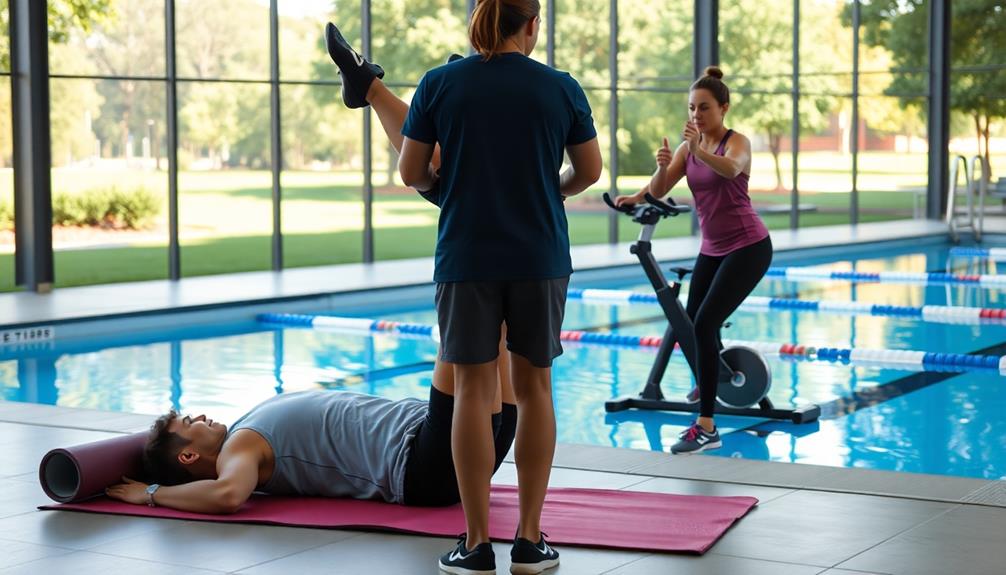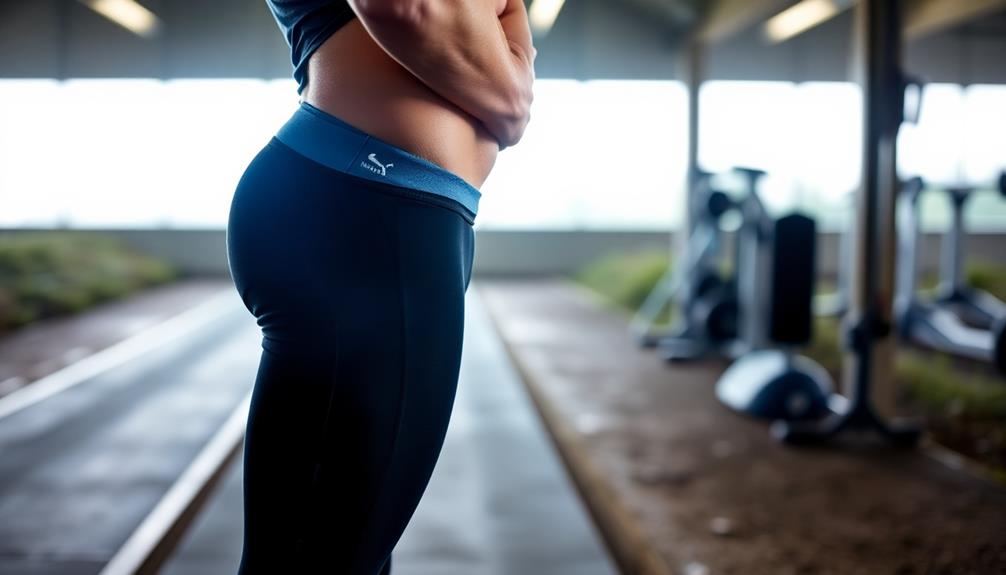After an endurance workout, you can speed up muscle recovery with these five techniques. Start with active recovery, like light jogging or swimming, to promote blood flow. Use foam rolling to massage tight muscles and reduce soreness. Try compression gear to improve circulation and reduce swelling. Take an ice bath to decrease inflammation and muscle pain. Finally, focus on proper nutrition and hydration, consuming a balanced meal and replenishing fluids. These methods will help your muscles heal faster and get you ready for your next training session. Explore each technique to maximize your recovery potential.
Core Insight
- Active recovery with light exercise promotes blood flow and speeds up muscle healing.
- Foam rolling massages tight muscles, improving circulation and reducing post-workout soreness.
- Compression gear aids recovery by enhancing blood flow and reducing muscle swelling.
- Ice bath therapy within 30 minutes of exercise helps reduce inflammation and muscle pain.
- Proper nutrition and hydration replenish energy stores and support muscle repair after endurance workouts.
Active Recovery

Active recovery is a great way to help your muscles heal after a tough workout. It means doing easy exercises that get your blood moving and make your muscles less stiff. You should do activities that use the same muscles you just worked out, but not as hard. You can also use a foam roller to massage specific muscles and help them relax.
Try going for a light jog, swim, or bike ride for 15-20 minutes. This will help get rid of lactic acid and bring oxygen-filled blood to your muscles. Gentle stretching or yoga can also help improve flexibility and reduce muscle tension. Just remember to keep it easy – you shouldn't be breathing hard or feeling strained.
Try to do active recovery 1-2 days after your big workout. This will help your muscles recover faster and get you ready for your next intense training session.
Foam Rolling

Foam rolling is a simple way to massage tight muscles after exercising. You'll need a foam roller, which can be firm or textured. These rollers help your muscles recover and improve blood flow.
To start, put the roller under the muscle you want to target. Roll back and forth slowly, pushing down firmly. If you find a sore spot, stop and hold for 20-30 seconds. This helps relax the muscle.
Focus on big muscle groups like your thighs, calves, and back. Spend 1-2 minutes on each area. Breathe deeply and relax as you roll. With regular practice, you'll notice better flexibility and less soreness after workouts.
Compression Gear

Compression Gear: A Popular Recovery Tool for Athletes
More and more athletes are using compression gear to recover after long workouts. This special clothing squeezes specific muscles, which may improve blood flow and reduce soreness. Compression levels usually range from 15-40 mmHg. Higher levels provide more support and better blood flow. When buying compression gear, think about the material. You want it to be comfortable and long-lasting.
How to Use Compression Gear:
- Get the right size. It should be snug but not too tight.
- Put it on right after your workout.
- Wear it for 1-2 hours after exercise, or even overnight for more benefits.
- Use sleeves or socks to target specific areas.
Benefits You Might Notice:
- Less muscle swelling
- Faster removal of waste products
- Less muscle soreness
- Faster recovery between workouts
Studies are still being done, but many athletes believe compression gear helps them recover better.
Ice Bath Therapy

Ice baths are a great way for athletes to recover after tough workouts. The cold water helps reduce swelling and muscle pain. More and more athletes are using ice baths to heal faster and perform better. Here's a simple guide to trying ice bath therapy:
- Get the bath ready: Put cold water and ice in a tub. The water should be 50-59°F (10-15°C).
- Pick the right time: Get in the ice bath within 30 minutes of finishing your workout.
- Get in the tub: Sit in the water up to your chest. Stay in for 10-15 minutes.
- Just breathe: Take slow, deep breaths to stay calm in the cold water.
- Warm up slowly: When you're done, dry off and do some light activity to warm up.
- Drink water: Have some water after the bath to help your body recover.
Proper Nutrition and Hydration

Eating right and staying hydrated are essential for muscle recovery after long workouts. Eat a meal with protein, carbs, and healthy fats within 30 minutes of finishing. Quick-digesting carb powders can help restore energy levels fast. Mix them into a drink for easy consumption.
Remember to drink plenty of fluids. Intense exercise makes you sweat a lot, so you need to replace that water. Drink 16-20 ounces per pound lost during your workout. Sports drinks are also good for restoring electrolytes.
Frequently Asked Questions
How Long Should I Wait Before Starting My Next Intense Workout?
You should typically wait 48-72 hours before your next intense workout. Listen to your body, as recovery time varies. If you're still sore or fatigued, give yourself more rest. Proper recovery is essential for progress.
Can Massage Therapy Help With Muscle Recovery After Endurance Workouts?
Yes, massage therapy can greatly aid your muscle recovery after endurance workouts. It'll improve blood circulation, reduce muscle tension, and decrease soreness. You'll experience faster healing and be ready for your next workout sooner. It's a valuable recovery tool.
Are There Any Supplements That Can Aid in Muscle Healing?
Yes, you'll find several supplements that can aid muscle healing. You should consider trying protein powders, branched-chain amino acids (BCAAs), creatine, and omega-3 fatty acids. Don't forget about vitamin C and D, which also support recovery.
How Does Sleep Quality Affect Muscle Recovery After Endurance Training?
Your sleep quality greatly impacts muscle recovery after endurance training. When you sleep, your body repairs and rebuilds muscle tissue. Poor sleep can hinder this process, slowing recovery and potentially increasing your risk of injury.
What Role Does Stretching Play in Muscle Healing Post-Endurance Workouts?
Stretching plays an important role in your post-endurance muscle healing. It'll improve flexibility, reduce muscle tension, and enhance blood flow. You'll experience less soreness, faster recovery, and better overall performance if you incorporate stretching into your routine.

